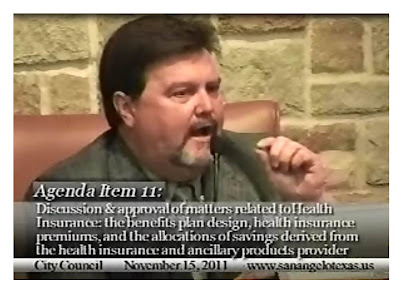It's not the city's new low cost mammography service, but how employees will go from two local providers to one. San Angelo Community Medical Center is the new exclusive provider for city workers and retirees. Shannon Medical Center will be shut out.
As a result, the city will squeeze retirees a little less than last year. A small portion of the $483,000, roughly 29%, will go to lower employee/retiree dependent premiums. Council made this decision in a November meeting.
The second shows how the city plans to utilize $343,000 in Early Retiree Reinsurance Program (ERRP) funds, a decision made December 20th.
It involves shifting money from one sack to another to avoid requirements, something generally frowned up by funders.
The council ended up voting 5-1 to apply the $343,287 to pay 2012 (i.e. current, immediate) claims and then take a comparable amount out of the city's self insurance fund and put it into the fund balance (i.e. the savings account fund within the health insurance fund), so that there are not "federal strings" attached to how that money can be used in the future. The motion approved stipulated that the money will be used for rate stability or possible catastrophic claim experience.
Oddly, for all the talk of federal strings, City leaders failed to identify ERRP's sole requirement. An employer must use ERRP money to offset increases in health insurance premiums/costs.
One might expect Human Resources and Risk Management Director Lisa Marley to clearly state the city's intended use of funds and federal requirements. She didn't.
While City Finance Chief Michael Dane dubbed his "avoid federal strings" strategy "compliant", I have serious doubts about substituting federal money for local.
City leaders state health insurance costs will go down in 2012. Federal money cannot supplant local, such that an employer spends less on health insurance than the prior year. Yet, that's exactly COSA's plan.
"We believe we've been betrayed." Russell SmithWhen Retired Police Chief Russell Smith finished his public testimony, even the Rushmores' (faces sitting on high perches) were speechless. It echoed Council Chambers the first time Smith uttered the dreaded "ERRP" in November 2010. In between, it's been a black comedy of incompetence and/or mendacity.
My guess? It's a bit of both, given a number of city leaders wish to eventually tap the health insurance fund surplus for capital items. As of 11-30-11 the health insurance fund surplus stood at $1.3 million, up from nearly $1 million two months prior. These amounts do not include the $343,000 in ERRP cash.
The rush to implement a multi-stage plan, amidst ignorance of ERRP requirements, could imperil the money intended to help soften future blows for city retirees.
Every picture tells a story and the City offers a hapless ERRP tale. Fortunately, it's all on tape, even the convoluted motion which failed to make the meeting minutes.
Update 3-9-14: Sponsors must comply with record maintenance requirements and provide records upon request in connection with audit or other ERRP integrity related activities. The Sponsors must maintain records for 6 years after the expiration of the plan year in which the costs were incurred, or longer if otherwise required by law. The records that must be retained are as follows— (1) All documentation, data, and other information related to the regulations, and (2) Any other records specified by the Secretary. The Secretary may issue additional guidance addressing record keeping requirements, including (but not limited to) the use of electronic media. The sponsor must require its health insurance issuer or employment based plan, as applicable, to maintain and produce records upon request.


















































